With the growing global demand for computing capacity, it’s clear that there is a need for new strategies to store and process information in an energy-efficient way. This requires not only enhancements to current technology but also fundamental research in game-changing approaches.
Considering the fact, Radboud physicists are laiding a foundation of a completely new generation of computers. They are working on a so-called “quantum brain” that can mimic the autonomous behavior of neurons and synapses in a brain. They have demonstrated that they can pattern and interconnect a network of single atoms.
They discovered that by constructing a network of cobalt atoms on black phosphorus they were able to build a material that stores and processes information in similar ways to the brain and, even more surprisingly, adapts itself.
By creating tailored ensembles of these atoms, scientists discovered that the firing behavior of these ensembles mimics the behavior of a brain-like model used in artificial intelligence. While noticing the behavior of spiking neurons, they also created the smallest synapse known to date.

Unwittingly, they saw that these ensembles had an intrinsic adaptive property: their synapses changed their behavior contingent upon what input they “saw”.
Khajetoorian said, “When stimulating the material over a longer period of time with a certain voltage, we were very surprised to see that the synapses actually changed. The material adapted its reaction based on the external stimuli that it received. It learned by itself.”
Scientists are now planning to construct and build a larger network of atoms, as well as dive into new “quantum” materials that can be used. Also, they need to understand why the atom network behaves as it does. ‘We are at a state where we can start to relate fundamental physics to concepts in biology, like memory and learning.”
Khajetoorians said, “If we could eventually construct a real machine from this material, we would be able to build self-learning computing devices that are more energy efficient and smaller than today’s computers. Yet, only when we understand how it works – and that is still a mystery – will we be able to tune its behavior and start developing it into a technology. It is a very exciting time.
Journal Refenerce:
- Kiraly, B., Knol, E.J., van Weerdenburg, W.M.J. et al. An atomic Boltzmann machine capable of self-adaption. Nat. Nanotechnol. (2021). DOI): 10.1038/s41565-020-00838-4
